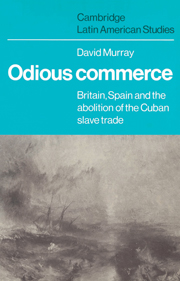Book contents
- Frontmatter
- Contents
- Tables
- Preface
- 1 The ‘opening’ of a legal trade
- 2 Parliament versus Cortes
- 3 Legality and illegality
- 4 The treaty of 1817
- 5 Enforcement and re-enforcement: the attempt to make the slave trade prohibition effective
- 6 The treaty of 1835
- 7 An abolitionist era
- 8 The Turnbull affair
- 9 The Escalera conspiracy
- 10 The penal law of 1845
- 11 Free trade and annexationism
- 12 The failure of the penal law
- 13 A new class of slaves
- 14 The abolition of the Cuban slave trade
- Abbreviations
- Notes
- Bibliography
- Index
- CAMBRIDGE LATIN AMERICAN STUDIES
8 - The Turnbull affair
Published online by Cambridge University Press: 16 October 2009
- Frontmatter
- Contents
- Tables
- Preface
- 1 The ‘opening’ of a legal trade
- 2 Parliament versus Cortes
- 3 Legality and illegality
- 4 The treaty of 1817
- 5 Enforcement and re-enforcement: the attempt to make the slave trade prohibition effective
- 6 The treaty of 1835
- 7 An abolitionist era
- 8 The Turnbull affair
- 9 The Escalera conspiracy
- 10 The penal law of 1845
- 11 Free trade and annexationism
- 12 The failure of the penal law
- 13 A new class of slaves
- 14 The abolition of the Cuban slave trade
- Abbreviations
- Notes
- Bibliography
- Index
- CAMBRIDGE LATIN AMERICAN STUDIES
Summary
The celebration of the end of apprenticeship in the British Caribbean colonies in 1838 was a triumphal acknowledgement by British abolitionist leaders that their long campaign against slavery in the British empire was over. This great success encouraged them to set their sights on much larger targets, the foreign slave trade and foreign slavery. The goal now was to abolish slavery all over the world. The United States, naturally, was the main culprit in the Americas, closely followed by Brazil and Cuba where the slave trade still flourished in spite of treaties outlawing it.
Led by the Quaker businessman, Joseph Sturge, the abolitionists in Britain organized the British and Foreign Anti-Slavery Society in 1839, believing that a new and efficient organization was a necessary prerequisite if the movement was to accomplish its world-wide aim. The international emphasis of the British and Foreign Anti-Slavery Society was only natural since the battle had been won in the British empire, but it implied changed tactics. Pressure on the British Parliament could at best have an indirect effect on the foreign slave trade and on foreign slavery. The focus would have to be on world opinion and, to some extent, away from direct political action. Given the dominance of Quakers in the Society–nearly half the members of the governing committee in the first thirty years of the Society's existence were Quakers – the strong pacifist convictions of this resurgent abolitionist movement should not be surprising.
- Type
- Chapter
- Information
- Odious CommerceBritain, Spain and the Abolition of the Cuban Slave Trade, pp. 133 - 158Publisher: Cambridge University PressPrint publication year: 1981



